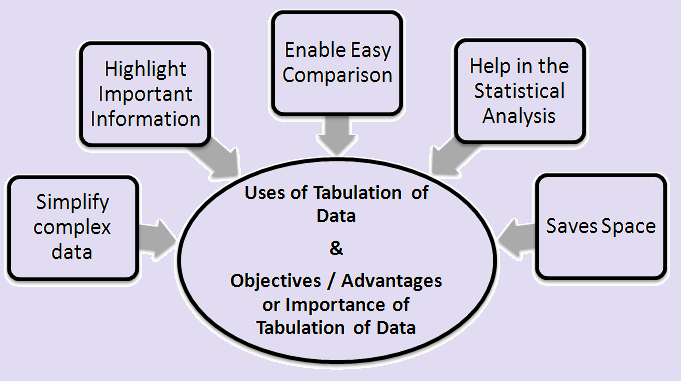
Uses of Tabulation of Data / Objectives & Advantages or Importance of Tabulation of Data
Uses of Tabulation of Data:
Tabulation, essentially, is a technique for filling the gap between the collection of data and their analysis. The following are the most common applications and main uses of tabulation of the data over textual presentation:
1. Tabulation is compulsory for the creation of charts and graphical representations.
2. In the policy-making, decision-making, and strategy formulation processes, data tabulation and these diagrammatic representations are very important.
3. Tabulation highlights and brings out essential and important features of data.
4. Tabulation helps in the Statistical Analysis of Data.
5. Data errors can be easily detected during tabulation.
6. Tabulation is used to make it possible to incorporate fresh results as they become available, and sometimes to remove out-of-date or irrelevant data.
Objectives, Advantages or Importance of Tabulation of Data:
Data can be presented in a tabular format to reduce space without sacrificing quality or quantity. The following are the advantages, importance, and objectives of tabulation of data over textual presentation:
1. Tabulation makes complex data simple, concise, and to the point.
When any data is tabulated, it decreases the mass of information, i.e., it simplifies and meaningfully reduces raw data so that it may be easily interpreted by a common man in less time. As a result, the tabulation is used to provide results in a compact manner that the less able, or those who have less time, can take in more rapidly and understand.
To put it another way, when the data is tabulated, the raw data volume is reduced and presented in a much more simple way. This makes previously complex (difficult) data easier to understand and analyse. As a result, the statisticians use tabulation to summarise data so that he does not have to handle raw data for each investigation he conducts.
2. Tabulation highlights and brings out data’s most important and essential characteristics.
In tabulation, the data is presented in a simple way without any textual explanation, so it highlights automatically the main characteristics of data without difficulty and delivers facts in a clear and concise manner without the need for textual explanation.
3. Tabulation makes the comparison easier.
When data is presented in rows and columns in an organised manner, it is easier to compare them using a variety of parameters. The representation of data in rows and columns helps for detailed comparisons of several parameters at the same time.
For example, when data for a country is presented in a table, it is easier to find the month when the country had the most rainfall. Otherwise, there is always the possibility of making a mistake when it comes to accurately processing the data.
4. Tabulation helps in the Statistical Analysis of Data.
Tables are the best source of organised data for statistical analysis. Statistical analysis is much easier when data is presented in a table in an organised manner.
In statistical analysis, data correlation, average, dispersion, etc. are computed. When data is presented in the form of a table, the task of computing average, dispersion, correlation, etc. becomes easy.
5. Tabulation helps you save space.
It saves space without compromising the quality or quantity of data.
Even if it does not appear to be as essential as the other tabulation objectives, reducing space without losing data quality can be immensely useful in the long run.
In tabulation, there is no repetition of explanatory matter. A table shows facts more clearly and also helps in the presentation of facts in a far more compact manner than the textual form.
Uses of Tabulation of Data & Objectives of Tabulation in Hindi
डेटा के सारणीकरण (Tabulation) के उपयोग:
सारणीकरण, अनिवार्य रूप से, डेटा के संग्रह और उनके विश्लेषण के बीच की खाई को भरने की एक तकनीक है। पाठ्य प्रस्तुति पर डेटा के सारणीकरण के सबसे सामान्य अनुप्रयोग और मुख्य उपयोग निम्नलिखित हैं:
1. चार्ट और ग्राफिकल निरूपण बनाने के लिए सारणीकरण अनिवार्य है।
2. नीति-निर्माण, निर्णय लेने और रणनीति निर्माण प्रक्रियाओं में, डेटा सारणीकरण और ये आरेखीय प्रतिनिधित्व बहुत महत्वपूर्ण हैं।
3. सारणीयन डेटा की आवश्यक और महत्वपूर्ण विशेषताओं पर प्रकाश डालता है और उन्हें सामने लाता है।
4. सारणीयन डेटा के सांख्यिकीय विश्लेषण में मदद करता है।
5. सारणीयन के दौरान आँकड़ों में त्रुटियों का आसानी से पता लगाया जा सकता है।
6. सारणीयन का उपयोग नए परिणामों के ज्ञात होने पर उन्हें शामिल करना संभव बनाने के लिए, और कभी-कभी पुराने या अप्रासंगिक डेटा को हटाने के लिए किया जाता है।
डेटा के सारणीकरण के उद्देश्य/ सारणीकरण का लाभ या महत्व:
गुणवत्ता या मात्रा का त्याग किए बिना, स्थान (जगह) को कम करने के लिए डेटा को एक सारणीबद्ध प्रारूप में प्रस्तुत किया जा सकता है। पाठ्य प्रस्तुति पर डेटा सारणीकरण के उद्देश्य, लाभ और महत्व निम्नलिखित हैं:
1. सारणीयन जटिल आँकड़ों को सरल, संक्षिप्त और सारगर्भित बनाता है।
जब किसी डेटा को सारणीबद्ध किया जाता है, तो यह सूचनाओं के ढेर को कम कर देता है, अर्थात, यह कच्चे डेटा को सरल और सार्थक रूप से कम कर देता है ताकि कम समय में एक आम आदमी द्वारा आसानी से व्याख्या की जा सके। नतीजतन, सारणीकरण का उपयोग एक संक्षिप्त रूप में परिणाम प्रदान करने के लिए किया जाता है कि जो कम सक्षम हैं, या जिनके पास कम समय है, वे अधिक तेज़ी से ग्रहण कर सकते हैं और समझ सकते हैं।
इसे दूसरे तरीके से कहें तो, जब डेटा को सारणीबद्ध किया जाता है, तो कच्चे डेटा की मात्रा कम हो जाती है और अधिक सरल तरीके से प्रस्तुत की जाती है। यह पहले के जटिल (कठिन) डेटा को समझने और विश्लेषण करने में आसान बनाता है। नतीजतन, सांख्यिकीविद डेटा को सारांशित करने के लिए सारणीकरण का उपयोग करते हैं ताकि उसे अपने द्वारा की जाने वाली प्रत्येक जांच के लिए कच्चे डेटा को संभालना न पड़े।
2. सारणीयन डेटा की सबसे महत्वपूर्ण और आवश्यक विशेषताओं पर प्रकाश डालता है और उन्हें सामने लाता है।
सारणीकरण में, आँकड़ों को, बिना किसी शाब्दिक स्पष्टीकरण के, सरल तरीके से प्रस्तुत किया जाता है, इसलिए यह बिना किसी कठिनाई के डेटा की मुख्य विशेषताओं को स्वतः हाइलाइट करने की गुंजाइश बढ़ाता है, और शाब्दिक स्पष्टीकरण की आवश्यकता के बिना ही, तथ्यों को स्पष्ट और संक्षिप्त तरीके से प्रस्तुत करता है।
3. सारणीकरण तुलना को आसान बनाता है।
जब डेटा को व्यवस्थित तरीके से पंक्तियों और स्तंभों में प्रस्तुत किया जाता है, तो कई मापदंडों के आधार पर उनके बीच तुलना करना आसान हो जाता है। पंक्तियों और स्तंभों में डेटा का प्रतिनिधित्व एक ही समय में कई मापदंडों की विस्तृत तुलना करने में मदद करता है।
उदाहरण के लिए, जब किसी देश में डेटा एक तालिका में प्रस्तुत किया जाता है, तो उस महीने का पता लगाना आसान हो जाता है जब देश में सबसे अधिक वर्षा हुई थी। अन्यथा, जब डेटा को सटीक रूप से संसाधित करने की बात आती है तो हमेशा गलती करने की संभावना होती है।
4. सारणीयन डेटा के सांख्यिकीय विश्लेषण में मदद करता है।
सारणियाँ (तालिकाएँ) सांख्यिकीय विश्लेषण के लिए संगठित डेटा का सबसे अच्छा स्रोत हैं। जब डेटा को एक व्यवस्थित तरीके से तालिका में प्रस्तुत किया जाता है तो सांख्यिकीय विश्लेषण बहुत आसान होता है।
सांख्यिकीय विश्लेषण में, डेटा सहसंबंध, औसत, प्रकीर्णन आदि की गणना की जाती है। जब डेटा को तालिका के रूप में प्रस्तुत किया जाता है, तो औसत, फैलाव, सहसंबंध आदि की गणना का कार्य आसान हो जाता है।
5. सारणीकरण आपको जगह बचाने में मदद करता है।
यह डेटा की गुणवत्ता या मात्रा से समझौता किए बिना स्थान बचाता है। भले ही यह अन्य सारणीकरण उद्देश्यों की तरह आवश्यक न प्रतीत हो, लेकिन डेटा गुणवत्ता को खोए बिना स्थान को कम करना लंबे समय में अत्यधिक उपयोगी हो सकता है।
सारणीकरण में, विवरणात्मक मामले की पुनरावृत्ति नहीं होती है। एक तालिका शाब्दिक रूप की तुलना में कहीं अधिक तथ्यों को स्पष्ट रूप से दिखाती है और कॉम्पैक्ट तरीके से तथ्यों की प्रस्तुति में मदद करती है।
(Source – Various books from the college library)
Copyrighted Material © 2019 - 2024 Prinsli.com - All rights reserved
All content on this website is copyrighted. It is prohibited to copy, publish or distribute the content and images of this website through any website, book, newspaper, software, videos, YouTube Channel or any other medium without written permission. You are not authorized to alter, obscure or remove any proprietary information, copyright or logo from this Website in any way. If any of these rules are violated, it will be strongly protested and legal action will be taken.




Be the first to comment